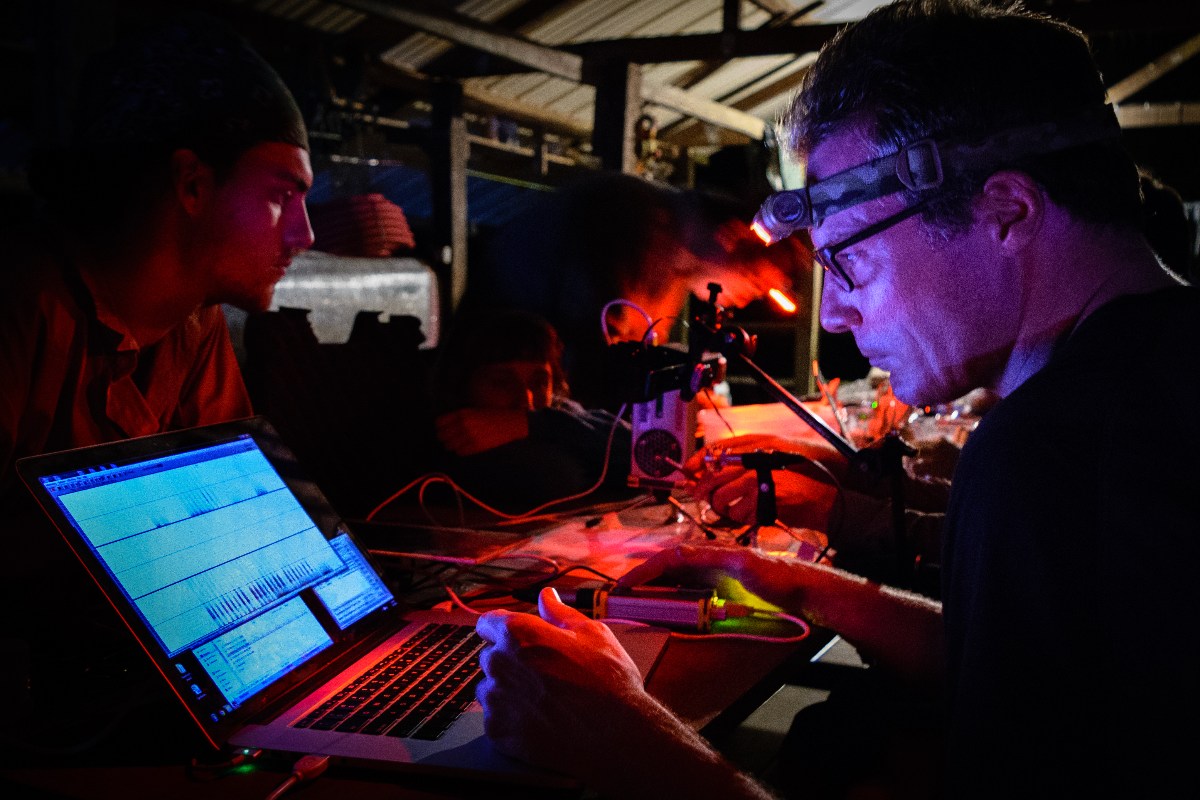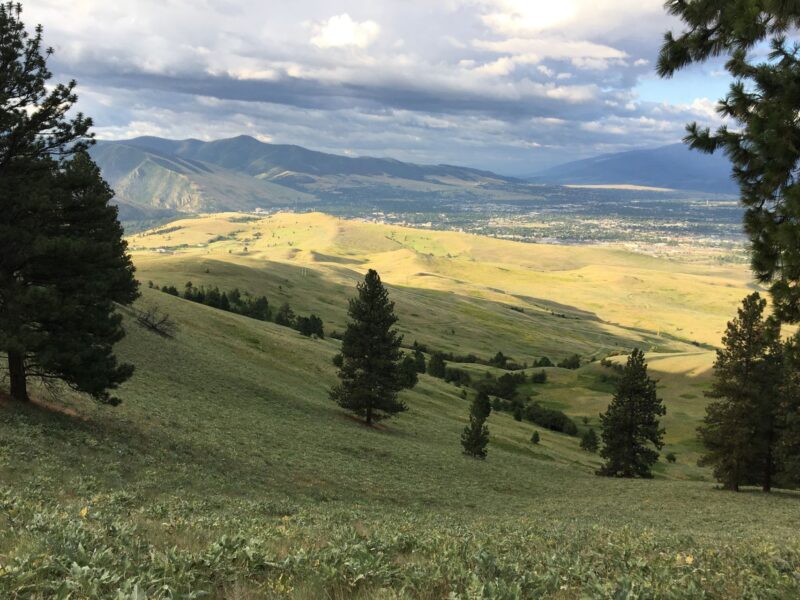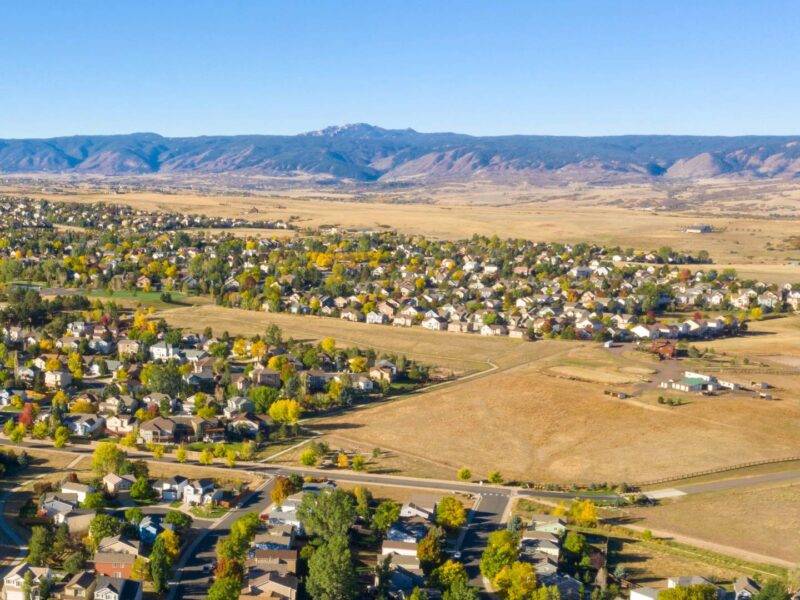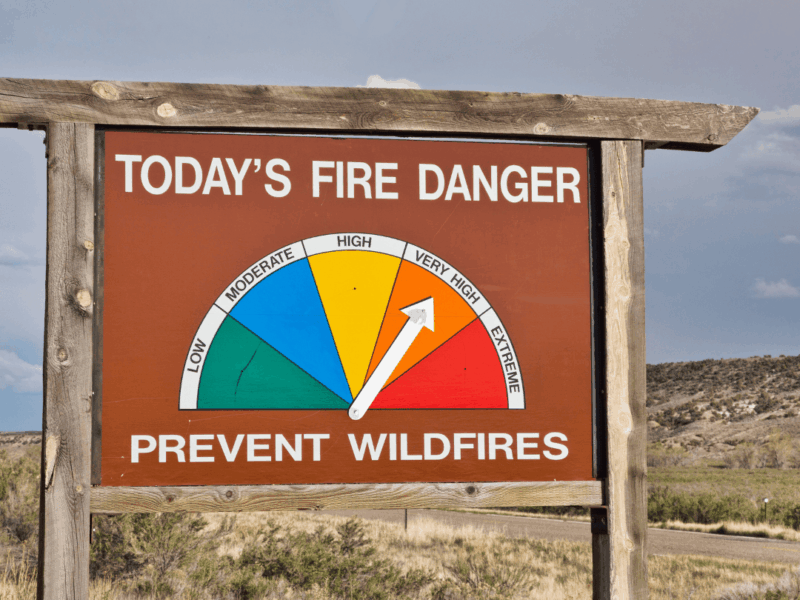Sensory Refuge: A conversation with Dr. Jesse Barber
I first had the pleasure of hearing Dr. Jesse Barber speak this summer. Outside under the dappled shade of large trees on the Lava Lake Lamb and Livestock Ranch in central Idaho, the setting could not have been more perfect. Landowners Kathleen and Brian Bean, and now their daughters Fiona and Phoebe, are pioneers in agriculture and conservation. Their years of hard, thoughtful work were evident that morning in the peace and abundance of life that surrounded us.
It was also the first time I had heard of a sensory ecologist.
Barber is a professor of biological sciences at Boise State University. He was recently appointed as the chief conservation curator and chief conservation scientist at the American Museum of Natural History in New York. Barber sat down for an interview with me for On Land to explain the field of sensory ecology, the role of private lands in sustaining a teeming realm of life largely invisible to humans, and its implications for land management and public policy.
LA: Jesse, you come to this work from a fairly unique background, starting from childhood in Alaska and then moving to Wyoming as a teen. Can you tell us a little more about that?
JB: So my dad was a wildlife manager. He was a grizzly bear biologist for the forest service. Being in the forest service is something like the military where you move every few years to advance. And so we lived all over the West, and most of the time in Alaska growing up. When my mom wanted more sunlight, my dad needed to find another job. At that point he was into grizzly bears so we moved to Wyoming and I graduated high school in Cody, Wyoming.
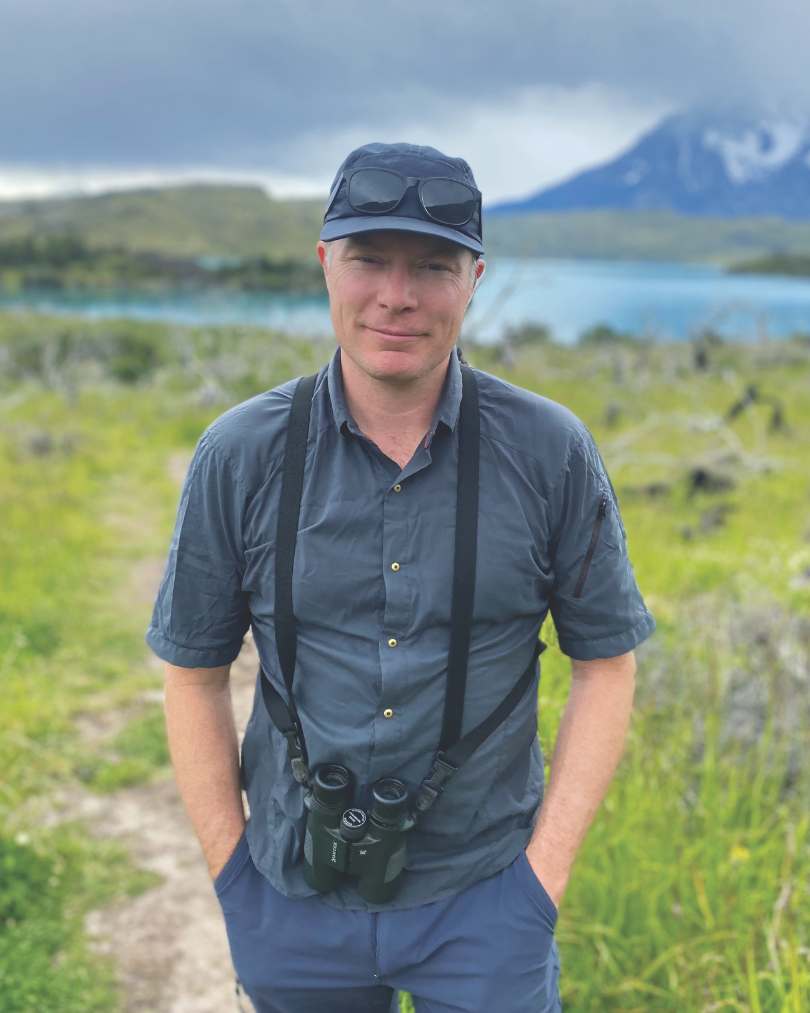
Dr. Jesse Barber was recently appointed as the chief conservation curator and chief conservation scientist at the American Museum of Natural History in New York.
LA: A true westerner! So now you are a specialist in the field of sensory ecology. And I have to admit that I had never heard of sensory ecology before I met you and I was immediately intrigued. What exactly is a sensory ecologist and can you give us some examples?
JB: Ecology, as you know, is the study of connections of life on Earth and sensory ecology is just a slightly new way of looking at it. Every life form, every animal, let’s say, has information that they acquire. Their senses structure what information they can access, and that has cascading consequences for how systems are arranged and how they evolve.
One of the reasons I got into this is because I study bats and insects. And bats, of course, use echolocation to orient. They scream out in frequencies above our ability to hear and listen for the returning echoes. Those echoes are the information they need to live their lives. If I play a recording of an echolocation attack and pull it down to the frequency we can hear, you’ll hear this speeding up of a pulse rate as the bat closes in on its insect prey. It’s something like a radar screen on an old submarine movie going faster and faster. And right at the end there’s a sound like a buzz, and that’s usually a dead insect.
So when you are thinking about bats, you have to imagine a different sensory world, one we don’t have access to or don’t understand. The reality is that all other animals also have their own umwelt, their own sensory world. By focusing on that, we can understand them better. That is what sensory ecology is.
LA: When you were speaking in Idaho, you gave some fascinating examples of this invisible world—invisible to us—that is taking place all around us and the ways in which anthropogenic noise and light impact these other forms of life. How do you study that? And can you tell us about the “phantom highway” you created?
JB: One of the first projects I launched after I did my post-doc at Colorado State University and in collaboration with the National Park Service was this phantom road project. That involved playing back recorded traffic noise at a very large scale and studying migratory birds. The basic idea was to test if noise was a driver of some of the negative effects we know exist from roads and other types of human infrastructure.
There are many reasons a road might have impacts on wildlife, but the primary reason I suspected noise was a major problem is because the effects we were seeing were at distances far enough away from the road that it seemed unlikely that these other factors were driving it.
To test that experimentally, we strapped a bunch of speakers to trees up in the foothills outside of Boise and we played back traffic noise. We tried to do it as authentically as possible in that the playbacks were timed to move from speaker to speaker so that it went down the line.
So, the only job of a migrating songbird is to pack on body fat, to go further on the journey and not get eaten. What we found is that about 30 percent of birds avoided the noise altogether. Those that stayed in the exposed area failed to gain weight, so they were not able to pack on body fat, meaning that noise is indeed a source of habitat degradation.
We strapped a bunch of speakers to trees up in the foothills outside of Boise and we played back traffic noise. What we found is that about 30 percent of birds avoided the noise altogether. Those that stayed in the exposed area failed to gain weight.
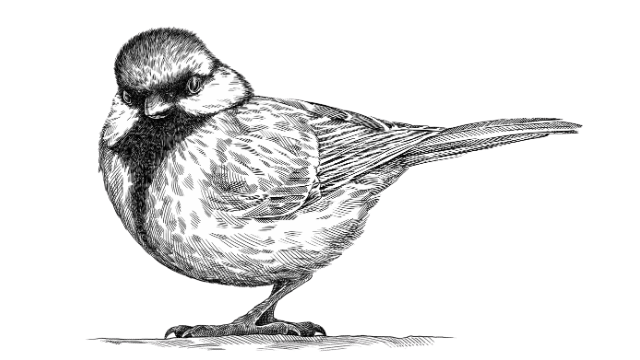
LA: Wow, that’s remarkable! One of the things you have highlighted is what happens to birds in urban areas.
JB: Yes, so this group had been studying white crowned sparrows in the Bay Area for a long time—multiple generations of researchers. They had been studying their songs. What they found during COVID, when the world got substantially quieter, is that these birds started singing a song that had never been recorded in the Bay Area before. So it turns out the birds had not been singing the most optimal songs for the quiet conditions because there were no quiet conditions. And when the quiet conditions arrived, thanks to the pandemic, they deployed those songs. That type of acoustic response likely happened all over the planet but this was one place where it was studied very well.
LA: We’ve been thinking a great deal at WLA lately about the impacts of recreation on wildlife and on surrounding private lands. What are you seeing?
JB: Roads are the most dominant source of human infrastructure on the planet. The U.S. Forest Service manages more miles of road than any other entity on Earth, any other country, because of the extensive logging trails. And those logging roads tend to get used by ATVs and other forms of transportation by humans.
We’ve known for a long time that trails drive wildlife away. We actually just completed an experiment this year that took the same approach as the phantom road, but we played back recreationalist sounds of people hiking, mountain biking and a person on an ATV. This was in collaboration with the U.S. Forest Service Research Station with Kathy Zeller and Mark Ditmer. The basic punchline is that animals ran away, and they did so for up to a week after exposure. And there was about a two times lower abundance of wildlife along those trails during these playbacks. They were five times more likely to flee and four times more likely to be vigilant.
And group size mattered. The bigger the group, the more avoidance behavior we saw. And although we only tested one ATV, it had a similar impact to a group. What we understand from this is that the sounds of people can have an impact at much greater distances than the actual trail. So from a management standpoint, you can start to think about buffering trails.
LA: The web of trail systems that we’re creating is extensive and there seems to be an emphasis on building ever more trails and getting more people outdoors. I think everyone supports the idea of people being out in nature, so in addition to trail buffers, what else can be done? Are there times of day or seasons when we need to be quieter in the field?
JB: Yes, for sure. The crepuscular periods, dusk and dawn, are some of the most important times for wildlife. It’s why people hunt at those times because that is when the animals are out and moving. It’s also when a lot of animals vocalize because their calls carry much further in those acoustic conditions than they do at midday.
Those periods are the most important biologically, and if you did limit exposure during those periods you would undoubtedly have ecological relief. But in the end it comes down to education and regulation. As we know, federal agencies have very little funding to do these things. You could put in temporary trail closures but who is going to enforce it? And will people really pay attention? So it comes down to building trails, avoiding putting more trails in and thinking critically about it at the planning stage.
As we talked about in Idaho, this is really where private lands form this incredibly protective buffer for wildlife. That’s why we are always begging our friends that own these big ranches to please let me hunt there.
LA: What I think is fascinating to realize after learning about your research is that these private lands are not just a refuge for deer and elk and pronghorn and bears, but also for insects and birds because of the noise impacts. I’m also curious to hear more about the impacts of light.
JB: We know a lot less about light than we do about noise. The noise pollution literature in studying wildlife is only about 20 years old. Light pollution is maybe only a decade old. There are now multiple labs all over the world focusing on these questions but we already have some pretty good data that light changes animal movement.
A lot of the light pollution work I do is focused in U.S. national parks. We’re doing experiments changing out lighting to try to see what’s best for insects and bats ecologically but still providing for the needs of people. And the basic punchline is that the lighting we’re using now is not working. It’s shifted to these really bright blue LED fixtures that are as bad as it can be for wildlife. But if you move back to amber like the older fixtures—and of course you do it with LEDs for modern, low-energy, climate-friendly solutions—you can basically return the habitat to almost darkness and ecological functioning.
LA: Jesse, you’ve spoken about the urgency of conservation and the need for further investment by Congress. Can you tell us how you see the linkages between moths, bats and this bigger picture of life on Earth and human well-being?
JB: I have a few thoughts. One is protected lands, national parks, Wilderness with a capital “W.” They’re amazing things for someone who values biodiversity and the human experience in nature. But one of the major problems is that they are patchy, not connected and they are mountaintops. As you well know, the biodiversity tends to be on private land in a lot of the West because it’s at low elevation. The valley bottoms that are not developed are almost all private ranches and farms. Otherwise, they are subdivisions. They are all developed and biodiversity is pushed out of there.
So it really centers on saving private lands as the future for saving biodiversity, not just in the western United States but in the world. And how do we connect these ecologically minded private landowners and these national parks on the tops of mountains? We need to provide funding mechanisms that are going to allow that fabric to be connected so that as climate changes where animals need to live, they can move and flourish. That’s really the frontier of conservation.
A second thing I think about is related to our discussion about trails. We need to get people out in nature so that they want to save it, and we also need to minimize our impacts and maximize coexistence. So that means really smart design and management to localize impacts and leave land for wildlife.

A lot of the light pollution work I do is focused in U.S. national parks. We’re doing experiments changing out lighting to try to see what’s best for insects and bats ecologically but still providing for the needs of people.
LA: What would you hope that readers would take away from your research?
JB: Every animal on the planet sees the world differently than we do. We can’t use the way we look at the world to predict what they are going to care about and how they are going to be impacted. We have to be open to the idea of different experiences. And that translates to the way we look at the human world, too. Understanding that all of us have different lives and see the world slightly differently is a wonderful thing. It lets us solve problems in a more holistic, robust and resilient way. If we work together and factor in a lot of different perspectives, we will find the right answer.


